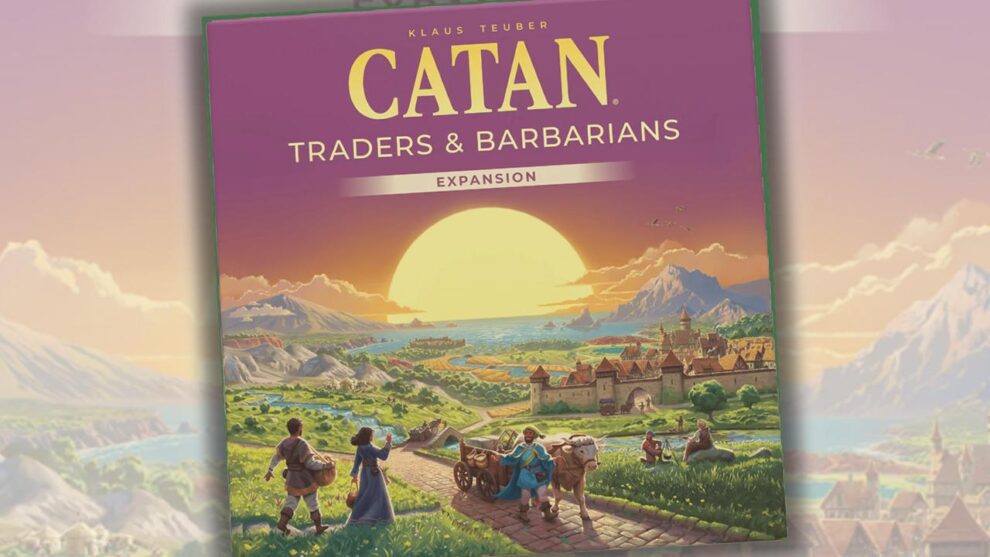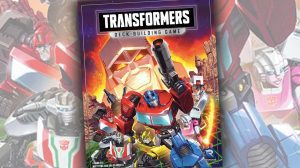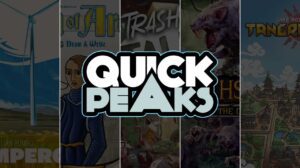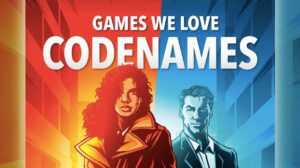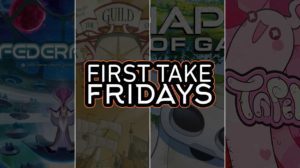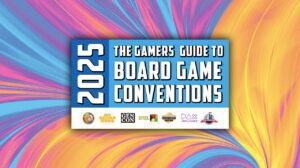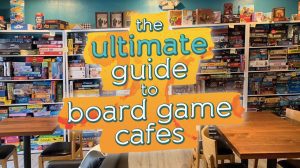Disclosure: Meeple Mountain received a free copy of this product in exchange for an honest, unbiased review. This review is not intended to be an endorsement.
Like many board game families, mine is a CATAN household. We’ve been playing as a family on and off for maybe five years, starting with CATAN Junior. I have been playing CATAN (base, as well as CATAN: Cities & Knights) for more than 20. The kids love trading, I love the dice chucking, and I think my wife likes it mainly as a chance to complain how long it takes everyone else to take their turns.
I recently had the chance to acquire a review copy of 2007’s CATAN: Traders & Barbarians thanks to the continuous reprint plans cycled by the team at CATAN Studio. I say continuous because the CATAN games are now on their sixth editions. SIXTH!! That means that every few years, we get a new version that makes it a little harder to implement old versions of the game with newly-purchased editions.
CATAN in 2025 is a pretty slick-looking production, if my copy of Traders & Barbarians is any indication. The rulebook is very good; even though previous versions of the game did the job, the layout of the Traders & Barbarians manual might be my favorite thing in the whole box. That’s important because this box includes four variants that can be added to any game of CATAN, as well as five scenarios, meant to be played only with this expansion and ideally in order, based on the way each scenario’s introduction is written.
For this review, I did three plays with the new stuff, based purely on what matters most: what modules I could get people in my network to play. That’s where we will start: CATAN, to a hobbyist, is a surprisingly tough sell.
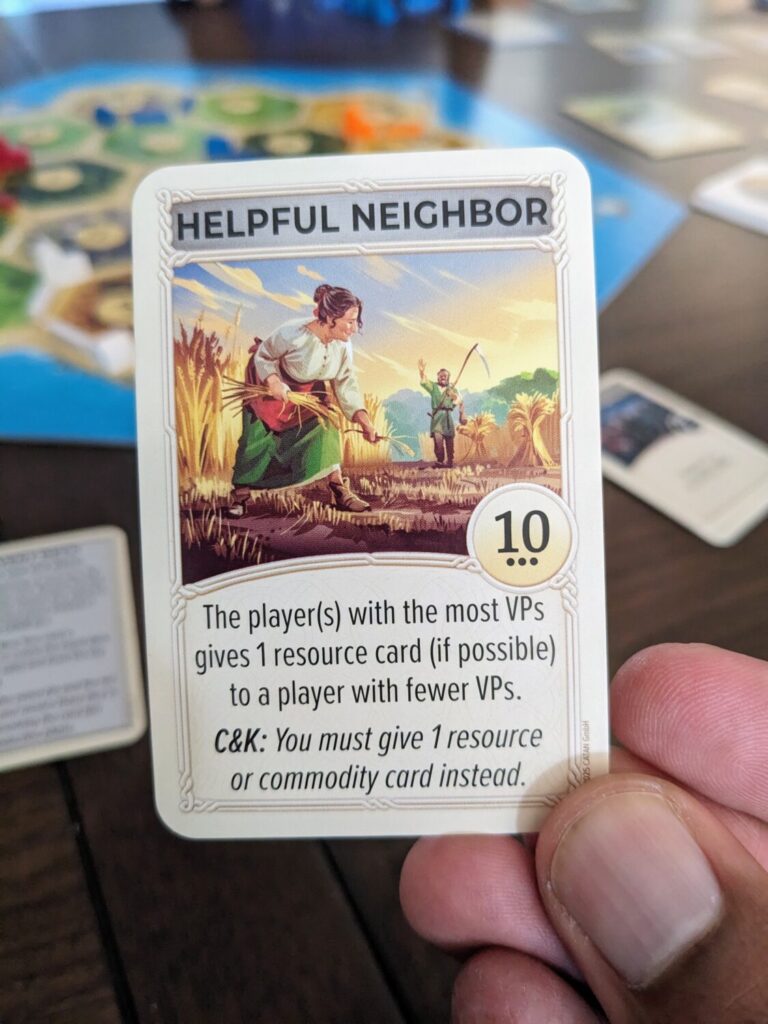
“Nah, I’m Good”
CATAN (born, to me, as The Settlers of Catan, before the word “Settlers” was dropped and Catan always appeared in CAPS) is now 30 years old. I have older games in my collection—goodness, Pay Day comes out monthly and it is 50 years old!—but from a hobbyist perspective, only a couple of my 18xx games are older than CATAN.
This is important, because across my four hobby gaming groups, no one ever tables CATAN now. Ever. I have my copy of CATAN purely for family gaming purposes. Even new-to-the-hobby gamers don’t want to play CATAN, or they at least don’t raise the prospect of playing CATAN with me.
For fun, I tried to play CATAN: Traders & Barbarians with my Wednesday group. This is the group that plays mostly lighter fare (Hot Streak comes out so often I’m beginning to get sick of Hot Streak) and helped create my Dusty Euro article series.
As I expected, I proposed CATAN: Traders & Barbarians and was swiftly met with a raft of objections. “Nah man, I’m good,” one would say whenever I suggested bringing it to a game night. “No way I’m playing CATAN,” another would offer. “I mean, if you are desperate for a review, I might be interested if you can get anyone else to play…but I never play CATAN any more.”
Gamers who have kids were more sympathetic, but still ended their conversations with a no. “We play base CATAN at home with the kids sometimes,” said one guy, a dad who has kids and lives a few minutes away. “I would play Traders & Barbarians, but I’d prefer to just play base CATAN. Or maybe Seafarers?” Most people I know stick to the CATAN threesome we all know best: base CATAN, CATAN: Cities & Knights, and CATAN: Seafarers. Anything outside of that sounds, to them, like a terrible idea.
Lessons learned. After pitching this to other groups, and after briefly considering putting this in front of my review crew (a group that suffered through the worst game I’ve tried in the series, CATAN: Dawn of Humankind), I settled on doing three plays with my family. Even that was wrought with challenges.
“Daddy, is this like Cities & Knights?” asked the 11-year-old. “Because that is my favorite game in the series.”
“I’m not sure yet, kiddo,” I responded. “But it looks like we can insert Cities & Knights into this expansion for some of the variants.”
“I’m not sure,” they said. “Let’s play Cities & Knights instead, and maybe later we can play this new game?”
As it turned out, I had to play Cities & Knights just to get the kids to buy in to playing Traders & Barbarians. So, that factored into my thinking about this entire review…I would only add Traders & Barbarians to your collection if you are 100% sure you can get it tabled. In today’s gaming environment, especially with the river of new games coming down the pike every year, CATAN has really struggled to stand out with experienced players.
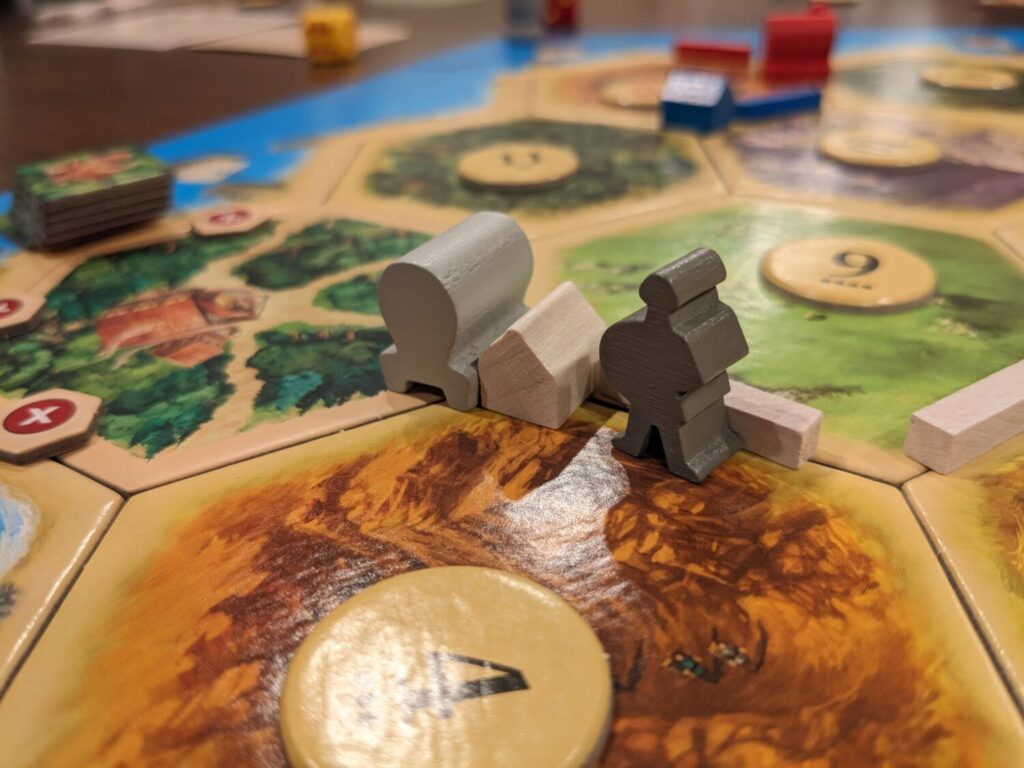
The Variants
For the purposes of this review, I’m going to assume you know how to play base CATAN. If you don’t, just type “CATAN” into the search box at the top of this page, and you can check out the wide array of CATAN content we’ve built just for you. Or, do what I tell anyone who is new to board games: buy a physical copy or pick up a copy of the digital app, available on all major platforms. No matter what my hardcore gamer friends noted above, CATAN is still one of the best designs in modern tabletop history.
CATAN: Traders & Barbarians comes with four variants that can be added to both the scenarios in this box, as well as previous CATAN games:
- The Friendly Robber
- Harbors of CATAN
- CATAN Event Cards
- CATAN for Two
The Friendly Robber is essentially a formal rule that says players can’t rob a person with only two victory points. Harbors of CATAN adds a tile similar to Longest Road and Largest Army that rewards building on port locations. We added Harbors of CATAN to one game and it was interesting to see how that inspired players to start the game by building on a port, especially one located next to a “red number” (a six or an eight) that also happened to be on a port, so I think that is always worth adding to a game of base CATAN.
The CATAN Event Cards were more divisive. In that same play with the Harbors addition, we also added the event cards. These cards include a mix of minor events that change up the rules for just a single turn, which isn’t the worst thing in the world. However, the events also replace the dice, meaning that each event card also has a number that is used to determine which hexes produce.
As anyone following my content already knows, I hate event cards. However, I do love a bit of randomness in my games…so, somehow, the event cards here both add events (normally, a net negative) and remove the threat of randomness by ensuring that all numbers get “rolled” during the distribution of the event cards. Still, on paper this should have been my least favorite addition to the Traders & Barbarians expansion.
In reality…I didn’t mind it. By building on a hex with a two or a twelve, I knew that at least once for each number, that was gonna mean production, which isn’t a bad thing. The event cards are sometimes no events at all—those cards are titled “A Beautiful Day”—and sometimes they are “Good Neighbors” cards that require each player to pass a resource card to the player on their left. This, plus the die results, provided for light amounts of drama each turn.
I’m sure you are thinking this, and you are right—that might mean that the draw deck is front-loaded with, say, all the six cards, meaning that you will have longer periods between your six hexes triggering again. But that was true whether we rolled the dice or not, right? And this means that a run of rolled fours is likely not going to derail an entire game, with other lower-frequency numbers not being rolled as often as those fours, for example.
My kids, who love rolling dice as much as I do, felt most robbed of the tactile experience of rolling dice, so as I expected, they hated the event cards. My wife was OK with them, in part because they speed up play. I liked the event cards more than I was expecting, but I still wouldn’t recommend the cards over simply rolling the dice. In some ways, I wish there was a “dice deck” and a separate event card deck, so that I could choose to add one or the other, but not both.
CATAN for Two was addressed simply each time I asked a family member to do it. “Isn’t CATAN better with more people?” my 11-year-old said, quoting my very own thoughts on how to play CATAN before declining the offer.
“Won’t trading be worse with less players?” my wife said.
“No, because I like robbing everyone,” said, predictably, my eight-year-old. CATAN for Two introduces trade tokens that allow for a player to get the stuff they need more easily from the supply, but even I had to admit—I don’t even enjoy base CATAN at three players as much as I do with four players, so CATAN for Two was never on the table.
Now, for people that insist on two-player game nights trying to fit CATAN into a two-player variant: this might be for you. Still, I do not recommend CATAN as a game where you trade with the bank, as opposed to bartering with other human beings. The trading is the magic of CATAN, and why I still think of it as such an interactive experience. Trading with only one other person isn’t as much fun!
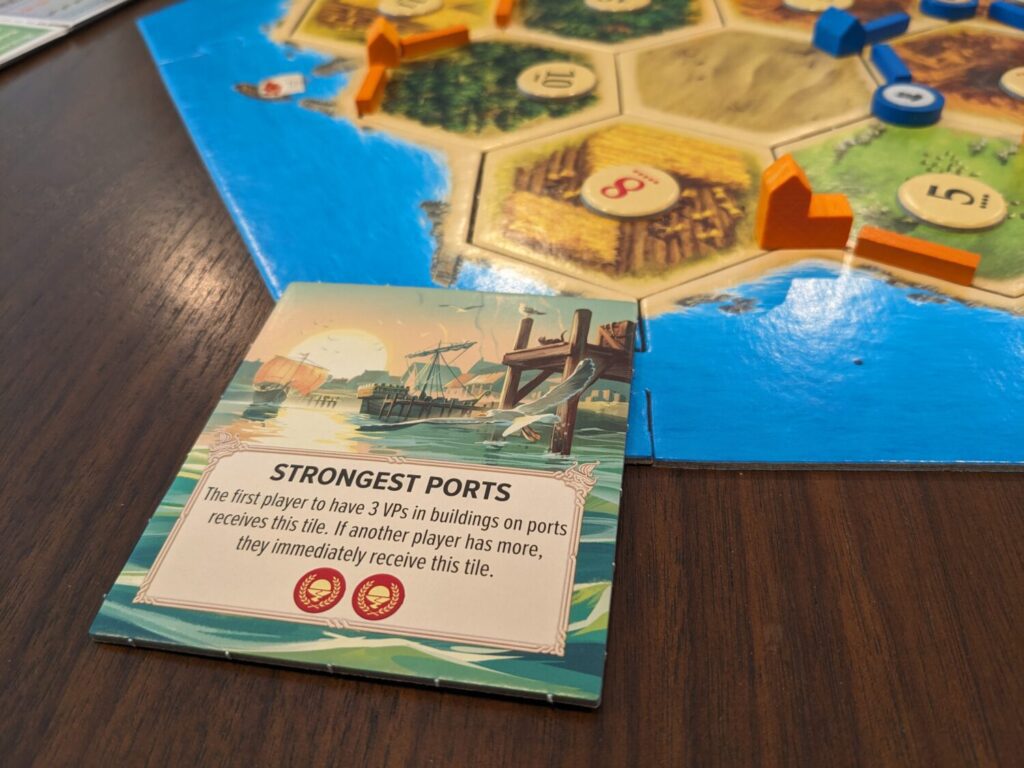
The Scenarios
CATAN: Traders & Barbarians comes with five scenarios:
- Fishing on CATAN
- Rivers of CATAN
- Merchant Trains
- Barbarian Attack
- Traders & Barbarians
When I pitched Fishing on CATAN and Barbarian Attack to the family, both were quickly shot down. Barbarian Attack is, on paper, a much more complicated version of how the barbarian ship and knights work in Cities & Knights, with much more upkeep on a turn-to-turn basis. When I considered the rules for Barbarian Attack, we decided it wouldn’t fit for a group that prefers the Cities & Knights version anyway.
Fishing on CATAN adds a lake tile as well as fishing ground vectors placed at intersections around the outer edges of the main play area (between ports, for example). These new tiles are used to generate fish tokens that can be spent for various rewards as an extra action during turns.
Fish tokens, generated when buildings next to these new tiles have their numbers rolled, do the same things that might happen if you just played base CATAN—five fish let you build a road for free, for example, and three fish can be spent to rob an opponent. These powers didn’t add anything new for us, but it did look like it might speed up a game of base CATAN. Nothing about the scenario sung to the family, so we skipped it.
“Daddy, can we just play the Traders & Barbarians scenario? It has the coolest pieces in the box.”
It felt right that my kids just wanted to play the expansion’s namesake scenario, but I still wanted to push for Merchant Trains and Rivers of CATAN…until I had to admit that I also wanted to play the Traders & Barbarians scenario. Merchant Trains did look interesting, maybe because my Hegemony: Lead Your Class to Victory gene was tickled by the idea of a voting round, where players vote on the placement of certain tokens.
So, Merchant Trains looked interesting…until I realized that voting rounds take place after every player’s turn. Every turn, in a game that might already take 90 minutes or more. That immediately killed off its chance of getting to the table.
Rivers of CATAN is my only regret. Two new multi-hex tiles are used to take the place of seven tiles from the base game’s grid, with a single river running through each section. New bridge tokens are used as road-adjacent pieces to get through those hexes, which can make for interesting connection combos for the right players. Coins, a new component used here and in other scenarios in this box, help or hurt players thanks to a new mechanic tied to total wealth. And Rivers of CATAN has almost no other changes to gameplay, making it an interesting addition.
But, the kids wanted to play Traders & Barbarians, so Traders & Barbarians is what they got.
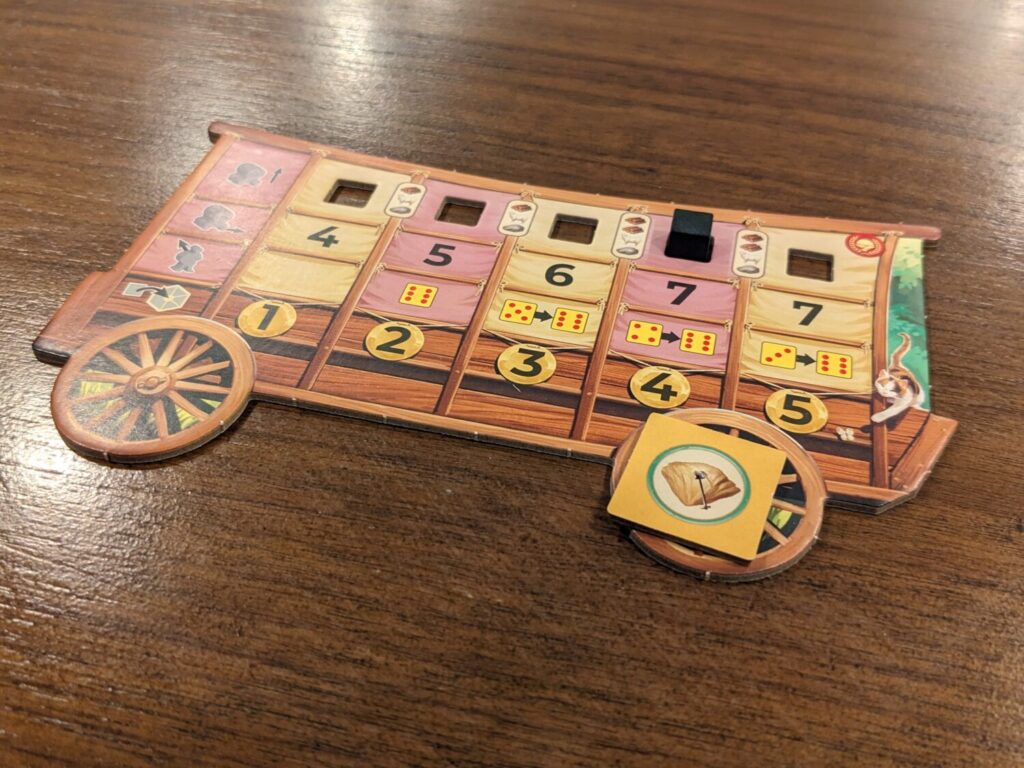
Wagon Wheel
Traders & Barbarians—the scenario—is a fun twist on the CATAN system. This scenario adds a pick-up-and-deliver variant that adds a cute wagon token to each player’s supply, along with a wagon board, which shows the current strength level of the wagon token along with its movement ability and rewards granted for each delivery.
The wagon token starts the game next to each player’s starting city. (This scenario uses the setup similar to how Cities & Knights begins, with players placing both a settlement then a city, with a starting score of three points.) At the end of each player’s turn, they can move their wagon along tile edges using a movement point system that incentivizes players to move along their own network if possible. Moving along empty edges costs two movement points, while moving along a road edge costs just one movement point.
Three new commodity hexes replace the desert, one pasture, and one field from the base game, and each of these hexes (placed in three corners of the map) serves as a way station to both pick up commodities and deliver them to different, separate locations. Each delivery offers both gold and a victory point, with gold used to trade with the supply at a 2:1 rate as much as twice per turn.
Those wagon boards? They can be upgraded, making the wagon a more powerful way to move around the board to grab commodities and get gold. The robber is replaced here by barbarian tokens, which slightly impede the progress of a wagon from time to time. The barbarian tokens are also the tokens used to rob other players when the seven is rolled. The map also has one other change because of the added commodity hexes: the two and the twelve counters are removed, meaning that when anyone rolls a 2/12, they must re-roll until they get a different result.
Traders & Barbarians really spiked the production engine in our games and the initially daunting task of scoring 13 VPs to win became child’s play. Everyone is trading. Everyone is delivering goods, in part because only barbarian tokens can get in the way of a wagon’s path, so everyone is getting a drip of gold and points through the delivery mechanic. This scenario comes with its own development card deck, and that deck still has Road Building cards, Knight cards, and victory points, so one could still achieve victory through cards or by getting the Largest Army tile (the Longest Road tile is not used here, however).
The new additions add real value and are easy to teach to experienced CATAN players. I think most gamers would be able to pick up CATAN for the first time even by starting with the Traders & Barbarians scenario, even if some of its nuances are unique to this play mode. My biggest concern was added playtime, but because players get points for delivered goods, a three-player game of Traders & Barbarians can be played in about an hour.
Still…
Traders & Barbarians (the complete expansion, not just the scenario) is a worthwhile addition for a player who considers themselves a collector. I think it will be difficult to regularly get it played—especially in a house like mine, where the family has already decided that CATAN: Cities & Knights is enough CATAN for them—but the more important call is tied to the value proposition.
The Traders & Barbarians scenario is a meaningful addition thanks to the new things it adds to the original formula. But the other four scenarios as well as the variants didn’t do enough for my group to warrant a purchase on their own. Now, if you insist on playing CATAN with only two players, and you think you will explore all the scenarios? That flips the thinking a bit, and is likely worth a look.
For other players, I would stick with the OG. Base CATAN still shines for me, Cities & Knights is great, and I will play Seafarers if others want to get it to the table. Traders & Barbarians is a lesser-known add-on and now, I see why!


